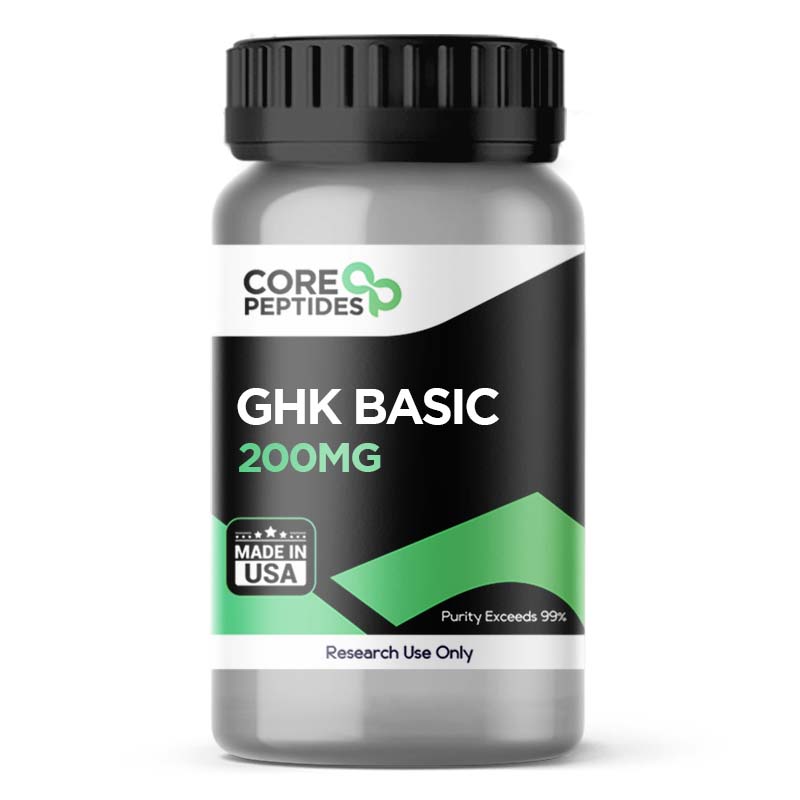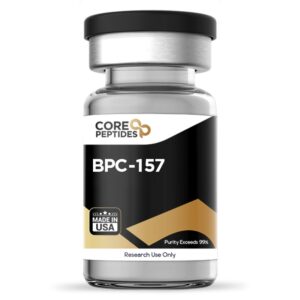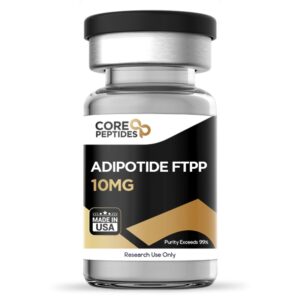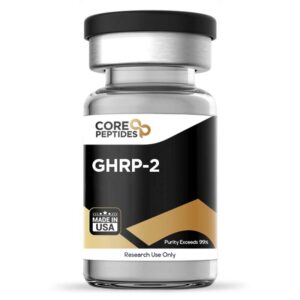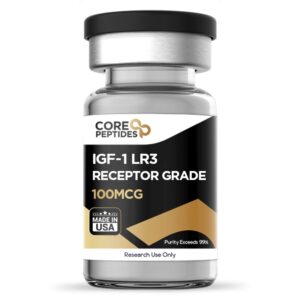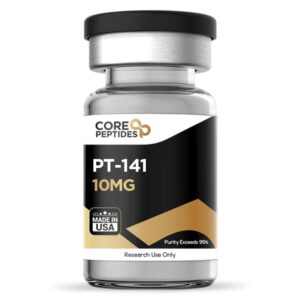GHK Basic (Tripeptide-1) (200mg)
$147.00
Size: 200mg
Contents: GHK Basic (Tripeptide-1)
Form: Lyophilized powder
Purity: >99%
SKU: P-GHK-TP-1
FREE Shipping on $200+ orders
Discount per Quantity
| Quantity | Discount | Price |
|---|---|---|
| 5 - 8 | 5% | $139.65 |
| 9 + | 10% | $132.30 |
GHK Basic (Tripeptide-1)
GHK Basic is a tripeptide composed of glycine, histidine, and lysine amino acids. It is a naturally occurring tripeptide in plasma, urine, saliva, and other fluids. GHK is produced by various cells, including fibroblasts, lymphocytes, and macrophages. It is also found in high concentrations in platelets and certain tissues, such as the liver and brain. GHK appears to have a high affinity to copper and may regulate numerous biological processes, including wound healing, tissue repair, and immune response.
GHK also has been suggested to have a role in regulating ion channels, enzymes, receptors, and gene expression. The levels of GHK appear to fluctuate over the course of cell lifespan, and it has been suggested that these changes contribute to cell aging. This may result in impaired tissue repair and regeneration and a decline in immune function. GHK may stimulate collagen production and play a role in wound healing and skin cell function. GHK may also have antioxidant and anti-inflammatory characteristics.
Chemical Makeup
Molecular formula: C14H24N6O4
Molecular weight: 340.38
Other known titles: Glycyl-L-histidyl-L-lysine, Tripeptide 1, NSC 379527, Copper peptide
Research and Clinical Studies
GHK Basic Peptide and Wound Healing
GHK has been primarily studied for its potential in wound healing. One clinical study evaluated GHK (its copper-bound version) in research models of diabetic neuropathic ulcers.(1) The models were subjected to a wound care protocol, and GHK was reported to increase ulcer closure compared to the vehicle. Larger plantar ulcers had a more pronounced enhancement of closure, with the incidence of ulcer infections reportedly lower in the GHK group. The scientists highlighted that the “incidence of ulcer infections was significantly lower (7% incidence compared with 34% for vehicle, p < 0.05) in the plantar ulcers treated immediately after debridement.”
Animal studies also suggest the potential of GHK in rapid wound healing. A study compared the actions of GHK on wound healing with control (not exposed to GHK) wounds in rabbits.(2) The wounds were evaluated daily, and planimetry was performed on days 7, 14, 21, and 28 to measure the unhealed wound area and the percentage of total wound healing. Results indicated that the GHK group exhibited greater neutrophil and vessel counts than the control group. The research team proposed that the peptide in question might potentially accelerate the recovery of wounds and the development of granular tissue, which refers to the new connective tissue and microscopic blood vessels that form on the surfaces of a wound during the recovery process. It is hypothesized that this action might be associated with increased activity of antioxidant enzymes—proteins that help protect cells from damage due to oxidative stress. Additionally, there might be an improvement in vascular development, meaning the formation and growth of new blood vessels within the wound, which is deemed crucial for delivering nutrients and oxygen that support tissue repair.
Another study also aimed to evaluate the actions of GHK on the recovery of ischemic open wounds in rats.(3) The GHK group appeared to exhibit a significant decrease in wound area compared to the control group. Wounds exposed to GHK were reported to contain lower concentrations of the pro-inflammatory markers, including tumor necrosis factor-alpha (TNF-alpha), matrix metalloproteinase-2 (MMP-2), and matrix metalloproteinase-9 (MMP-9). Each of these markers plays a role in the inflammatory response and tissue remodeling, indicating that GHK may mitigate inflammation and tissue degradation in ischemic wound environments.
In subsequent studies using typical murine models and those modified to simulate diabetic conditions, dressings made of collagen and enriched with GHK appeared to enhance the recuperation of wounds. The data indicates that by the end of the third week, wounds addressed with films containing biotinylated GHK approached near-total closure at 99.39%, which may represent a notable improvement over the 69.49% closure rate seen with control films. Moreover, these GHK-exposed wounds appeared to have exhibited higher concentrations of glutathione and ascorbic acid. These molecules are important antioxidants that may contribute to tissue repair. There was also a possible increase in epithelialization, which is the process of renewing the outer layer of the skin tissue in experimental models. Additionally, there may have been a stimulation of collagen production, which is vital for the skin's structural integrity, enhanced activity of fibroblasts—cells crucial for wound recovery —and an increase in mast cell activation, which plays a role in the inflammatory responses.
GHK Basic Peptide and Skin Cells
GHK may exhibit implications within the development of creasing and wrinkling along the stratum corneum of the skin barrier by potentially influencing the upregulation of collagen production.(5) It has been hypothesized that the underlying mechanisms for this observed phenomena may involve the presence of the tripeptide sequence Gly-His-Lys as a fragment typically released during the hydrolysis process of collagen. Hydrolysis of collagen, which occurs when collagen fibers are broken down, often results from tissue damage or degradation. Scientists have posited that "the presence of a GHK triplet in the alpha 2(I) chain of type I collagen suggests that the tripeptide might be liberated by proteases at the site of a wound and exert in situ healing." These peptide fragments might play a role in cellular signaling, particularly influencing fibroblasts, which are cells deemed critical for synthesizing new collagen fibers. This signaling is essential as it appears to trigger the fibroblasts to begin synthesizing collagen, thus contributing to tissue repair and regeneration. GHK may also stimulate elastin and glycosaminoglycans. Elastin is another vital protein contributing to the skin's elastic properties, while glycosaminoglycans are long polysaccharide molecules that play a role in maintaining and supporting the extracellular matrix. Together, these components are considered essential for maintaining the skin's structural integrity and functional characteristics.
Another clinical study reported that GHK appeared to improve collagen production and stimulated dermal keratinocyte proliferation under specific research conditions.(6) The studies also reported an apparent increase in skin thickness, improved skin hydration, and smoothing by stimulating collagen synthesis, skin elasticity, and increased production of type 1 collagen.
A further clinical study evaluated the efficacy of GHK for managing CO2 laser-resurfaced skin - a procedure that removes the epidermis and heats the derma.(7) A cohort of 13 models were randomly assigned to receive either post-procedure skin regimens with or without GHK. While there was no statistically significant difference in erythema resolution, both groups were reported to experience improvement in wrinkles and overall skin quality. Furthermore, models exposed to the GHK substance reported higher satisfaction with post-exposure improvement in overall skin quality than those without.
GHK Basic Peptide and Inflammation, Oxidative Stress
GHK may have antioxidant and anti-inflammatory potential that protect cells from damage caused by active radicals and lipid peroxidation. Studies report that the peptide may inactivate damaging free radicals that are by-products of lipid peroxidation and UV-light exposure.(8) The specific radicals reported by the researchers included 4-hydroxynoneal, acrolein, malondialdehyde, and others. Furthermore, GHK may completely block the oxidation of low-density lipoproteins. Additionally, GHK was suggested to have potential action in reducing iron release from ferritin, a lipid peroxidation catalyst.
Researchers report that GHK may reduce the formation of iron complexes in damaged tissues and thus reduce inflammation.(9) The study suggested that GHK acts by binding to the channels of ferritin involved in the iron release and may physically reduce the release of -Fe by a reported 87%, which may prevent inflammation and oxidation in damaged tissues.
The anti-inflammatory potential of GHK may also extend to organs such as the lungs. One animal model study investigated the actions of GHK on lipopolysaccharide-induced lung inflammation in mice.(10) The study suggested that GHK may reduce the production of reactive oxygen species and inflammatory cytokines while increasing the activity of antioxidant enzymes. It also may suppress the activation of NF-κB and p38 MAPK signaling pathways, decreasing TNF-1 and IL-6 production. Furthermore, the researchers reported that GHK appeared to attenuate lung histological alterations and reduce inflammatory damage in the lungs of mice with lung damage. The scientists reported that the peptide “suppressed the infiltration of inflammatory cells into the lung parenchyma in LPS-induced ALI in mice.”
GHK may also help reduce the oxidative stress caused by smoking. Scientists reported that GHK appeared to inhibit oxidative stress in alveolar epithelial cells by upregulating Nrf2 expression.(11) A study investigated the potential of GHK to reduce levels of reactive oxygen species in cell cultures.(12) The researchers suggested that the GHK action on the signal of hydroxyl radicals may be stronger than those of other antioxidative, endogenous peptides, such as carnosine and reduced glutathione.
GHK Basic peptide is available for research and laboratory purposes only. Please review and adhere to our Terms and Conditions before ordering.
References:
- Mulder, G. D., Patt, L. M., Sanders, L., Rosenstock, J., Altman, M. I., Hanley, M. E., & Duncan, G. W. (1994). Enhanced healing of ulcers in patients with diabetes by treatment with glycyl-l-histidyl-l-lysine copper. Wound repair and regeneration : official publication of the Wound Healing Society [and] the European Tissue Repair Society, 2(4), 259–269. https://doi.org/10.1046/j.1524-475X.1994.20406.x
- Gul, N. Y., Topal, A., Cangul, I. T., & Yanik, K. (2008). The effects of tripeptide copper complex and helium-neon laser on wound healing in rabbits. Veterinary dermatology, 19(1), 7–14. https://doi.org/10.1111/j.1365-3164.2007.00647.x
- Canapp, S. O., Jr, Farese, J. P., Schultz, G. S., Gowda, S., Ishak, A. M., Swaim, S. F., Vangilder, J., Lee-Ambrose, L., & Martin, F. G. (2003). The effect of tripeptide-copper complex on healing of ischemic open wounds. Veterinary surgery : VS, 32(6), 515–523. https://doi.org/10.1111/j.1532-950x.2003.00515.x
- Alven, S., Peter, S., Mbese, Z., & Aderibigbe, B. A. (2022). Polymer-Based Wound Dressing Materials Loaded with Bioactive Agents: Potential Materials for the Treatment of Diabetic Wounds. Polymers, 14(4), 724. https://doi.org/10.3390/polym14040724
- Maquart, F. X., Pickart, L., Laurent, M., Gillery, P., Monboisse, J. C., & Borel, J. P. (1988). Stimulation of collagen synthesis in fibroblast cultures by the tripeptide-copper complex glycyl-L-histidyl-L-lysine-Cu2+. FEBS letters, 238(2), 343–346. https://doi.org/10.1016/0014-5793(88)80509-x
- Abdulghani, A. A., Sherr, A., Shirin, S., Solodkina, G., Tapia, E. M., Wolf, B., & Gottlieb, A. B. (1998). Effects of creams containing vitamin C, a copper-binding peptide cream and melatonin compared with tretinoin on the ultrastructure of normal skin-A pilot clinical, histologic, and ultrastructural study. Disease Management and Clinical Outcomes, 4(1), 136-141.
- Miller, T. R., Wagner, J. D., Baack, B. R., & Eisbach, K. J. (2006). Effects of copper tripeptide complex on CO2 laser-resurfaced skin. Archives of facial plastic surgery, 8(4), 252–259. https://doi.org/10.1001/archfaci.8.4.252
- Cebrián, J., Messeguer, A., Facino, R. M., & García Antón, J. M. (2005). New anti-RNS and -RCS products for cosmetic treatment. International journal of cosmetic science, 27(5), 271–278. https://doi.org/10.1111/j.1467-2494.2005.00279.x
- Miller, D. M., DeSilva, D., Pickart, L., & Aust, S. D. (1990). Effects of glycyl-histidyl-lysyl chelated Cu(II) on ferritin dependent lipid peroxidation. Advances in experimental medicine and biology, 264, 79–84. https://doi.org/10.1007/978-1-4684-5730-8_11
- Park, J. R., Lee, H., Kim, S. I., & Yang, S. R. (2016). The tri-peptide GHK-Cu complex ameliorates lipopolysaccharide-induced acute lung injury in mice. Oncotarget, 7(36), 58405–58417. https://doi.org/10.18632/oncotarget.11168
- Zhang, Q., Yan, L., Lu, J., & Zhou, X. (2022). Glycyl-L-histidyl-L-lysine-Cu2+ attenuates cigarette smoke-induced pulmonary emphysema and inflammation by reducing oxidative stress pathway. Frontiers in molecular biosciences, 9, 925700. https://doi.org/10.3389/fmolb.2022.925700
- Sakuma, S., Ishimura, M., Yuba, Y., Itoh, Y., & Fujimoto, Y. (2018). The peptide glycyl-ʟ-histidyl-ʟ-lysine is an endogenous antioxidant in living organisms, possibly by diminishing hydroxyl and peroxyl radicals. International journal of physiology, pathophysiology and pharmacology, 10(3), 132–138.

